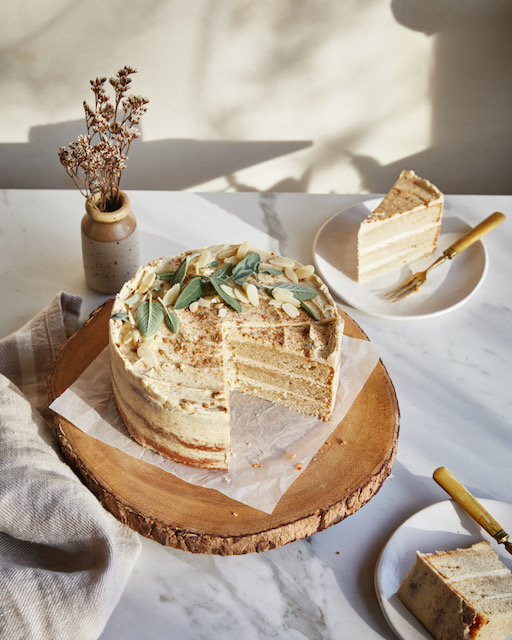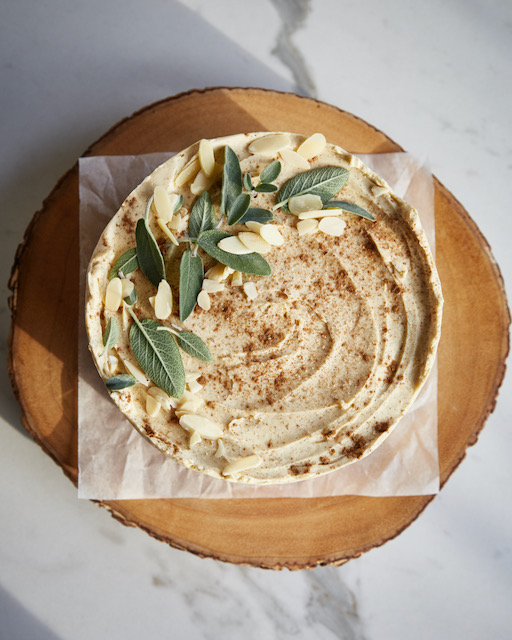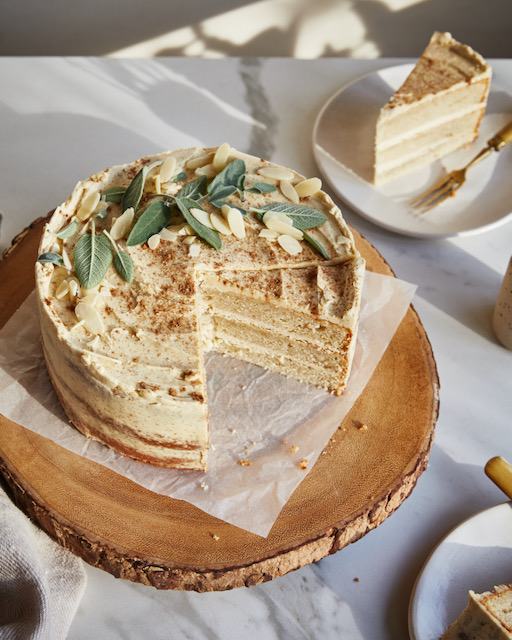Eggnog Layer Cake
Izy Hossack is a London based chef and baker, food stylist and food photographer, as well as author of the books Top with Cinnamon and The Savvy Cook. Izy has created two deliciously festive recipes for the Omlet Advent Calendar, you can find her Chocolate Gingerbread Bundt Cake here.


This layer cake is the perfect Christmassy bake to impress. Inspired by the flavours of eggnog, the cake and frosting are flavoured with vanilla, nutmeg, cinnamon and rum for a slightly boozy, warmly spiced dessert.
The frosting is an interesting one to try – if you usually find standard buttercream too sweet, you’ll love this version (and it doesn’t require icing sugar!). The base is a cooked custard, thickened with cornflour and egg until very viscous. This is then whisked into softened butter until fluffy and creamy. It can seem a bit dense if the butter or custard are too cold so you may need to add a splash of boiling water to help it fluff up properly. It’s definitely worth the extra effort over a standard buttercream as the texture is so smooth and light with the perfect level of sweetness.
For decoration, I like to keep the frosting simple with a thin layer around the outside and a slightly swoopy texture on top. For the toppings, I look for edible bits to give the cake a festive look; Woody herbs like rosemary, thyme or sage (as I’ve used here) are lovely as are chopped/flaked nuts. A sprinkle of cinnamon and nutmeg are a finishing touch and boost that eggnog flavour.
Ingredients:
Cake:
300g granulated sugar
140g unsalted butter, softened
60ml vegetable oil
4 medium eggs
150ml natural yoghurt
150ml milk
1 tsp vanilla paste or extract
330g self-raising flour
1 tsp ground cinnamon
¼ tsp freshly grated nutmeg
¼ tsp fine table salt
¼ tsp bicarbonate of soda
Frosting:
150ml milk
1 tsp vanilla paste or extract
80g granulated sugar
20g cornflour
1 egg
½ tsp ground cinnamon
¼ tsp freshly grated nutmeg
Pinch salt
200g unsalted butter, softened
2 tbsp dark rum
For the cake:
- Preheat the oven to 180C fan. Grease, line and flour three 18-cm cake tins.
- In a large bowl, cream the sugar and butter until pale and fluffy. Beat in the oil then eggs, one at a time.
- In a jug, combine the yoghurt, milk and vanilla.
- In a separate bowl, place the flour, cinnamon, nutmeg, salt and bicarbonate of soda and stir to combine.
- Add 1/3 of the yoghurt mixture to the butter mixture and stir to combine. Add 1/3 of the flour mixture to the butter mixture and stir to combine. Repeat in this alternating fashion until you’ve mixed in all of the yoghurt and flour mixtures and have a smooth cake batter.
- Divide the batter evenly between the cake tins and bake for 25-30 minutes, until a skewer inserted into the centre of the cakes comes out clean.
- Run a butter knife around the inside edges of the cake tins and then leave them to cool for 10 minutes before turning out onto a wire rack to cool completely.
For the frosting:
- Combine the milk and vanilla in a small pot and place over a medium-low heat on the stove until gently steaming.
- In a medium bowl, mix the sugar, cornflour, egg, cinnamon, nutmeg and salt until smooth.
- Pour a little of the hot milk into the egg mixture and quickly stir with a whisk until smooth. Stream in the remaining hot milk whilst stirring to combine. Pour the contents of the bowl back into the pot and return to the heat.
- Cook over a medium-low heat, stirring with a whisk, until the mixture becomes lumpy and thick. Keep stirring until it looks smooth and glossy, about 1 minute, then remove from the heat.
- Spread the mixture out in a shallow bowl and pop into the freezer for 5-10 minutes until cooled. Alternatively, chill the mixture in the fridge for around 1 hour.
- Beat the softened butter in a large bowl with an electric whisk (or in a stand mixer) until smooth then gradually add the cooled egg mixture, stopping to scrape down the sides and bottom of the bowl occasionally.
- Add the rum and keep whisking until the frosting looks aerated and light. If it seems too dense still, add 1-2 tbsp of boiling water to help soften the butter which should help the frosting to achieve the correct texture.
To assemble:
- Cut off any domed tops from the cooled cake layers using a serrated knife and peel away the baking paper from the bottoms.
- Place one cake layer onto a serving plate and spread a few heaped tablespoons of frosting over the top of the cake. Top with a second cake layer and repeat.
- When you’ve placed on the final cake layer, place ½ of the remaining frosting onto the cake and spread it thinly over the top and sides of the cake. Using a warm palette knife can be useful here (warm it up by placing into a jug of boiling water and wipe clean as needed).
- Place the cake into the fridge for 10 minutes to harden this initial layer of frosting.
- Remove the cake from the fridge and add the remaining frosting to the cake, using it to decoratively frost the top and sides as you like.
- Decorate the cake with any toppings you want – I’ve used grated nutmeg, ground cinnamon, sage leaves and flaked almonds here for a festive feel.

This entry was posted in Christmas